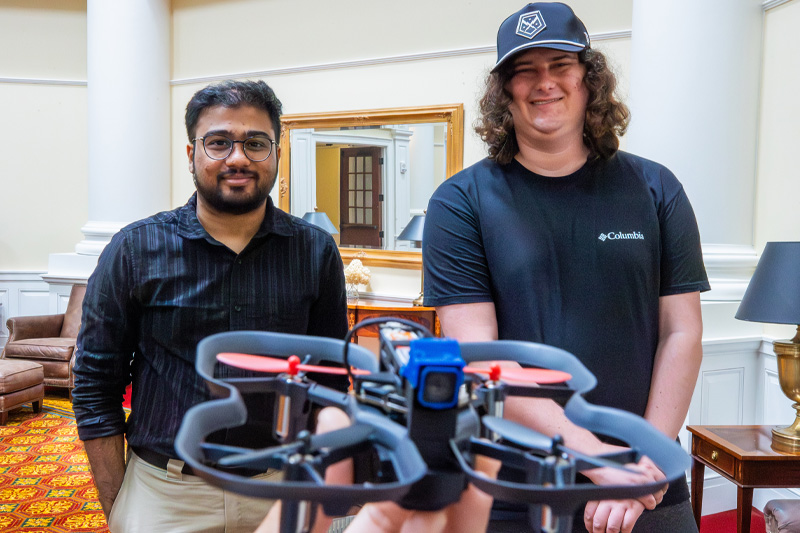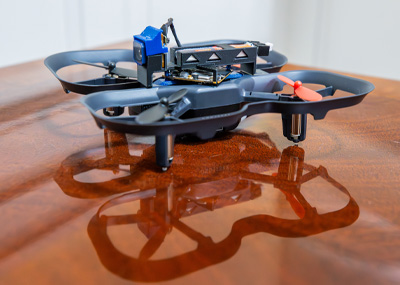
Read time:

Drones weighed heavily on Cole Thomsen’s mind this summer. Sort of.
Actually, the less they weighed the better, his stress dropping with each gram he shaved off.
Thomsen, a Summer Scholar, embarked on cutting-edge research that involved outfitting drones with special cameras.
Thomsen’s charge was to find an inexpensive way for drones available to the public to sport cameras that can be used in a multitude of ways. He needed to use his ingenuity and scientific know-how to combine math and materials to strike the ideal weight and design for the camera mount.
His focus was on the weight of the camera and its modular mount. Striking the perfect weight balance was difficult. It required creativity, persistence, and many tries at potential formulas.
“Our goal was 20 grams,” said Thomsen, ‘26 Information Science. “That’s what we needed to make this a viable project.”
Summer Scholars is a CNU collaborative program offered through the Office of Research and Creative Activity (ORCA) that pairs faculty with students to conduct paid research. Often, the research is published and a student’s career trajectory is elevated. Thomsen worked with Dr. Abhishek Phadke, a professor in the School of Engineering and Computing (SEC).
Because the drone and camera turned out to be incompatible, Thomsen’s project hit unexpected research turbulence and proved more complicated than anticipated. But, he persevered.
“I learned that a roadblock isn’t a reason to give up. I had a little voice in the back of my head that was constantly telling me that it wasn’t worth my time to design anything if it was certain that it wouldn’t work,” Thomsen said. “But I was able to work up the courage to bring the mount to completion, even if success wasn't a guarantee. I would say that I have changed. This experience was the closest thing to what a career in my industry would like.”
For Thomsen, research resulted in him not only advancing his technical knowledge, but also infused his work with real-world skills.
“The program was a great experience,” Thomsen said. “I was able to learn so much about my focus in computer-aided design, drones and 3D printing, but also on research on campus in general. It was good preparation for the job market, such as having 40-hour work weeks, attending meetings, having deadlines, and doing presentations of my work to others, and having other people around me also working on their research in the same room.”
The drone research comes at a pivotal time for CNU, as a two-story drone lab is one of the features of the new high-tech Science and Engineering Research Center (SERC), expected to open in January. The lab is designed to be a hub of innovation and progress for both students and the community to develop and test unmanned aircraft systems (UAS) and other robotics.
The endgame to Thomsen’s research was to design a mount that eventually can be used for different types of drone sensors.
During his Summer Scholar research, Thomsen tested the mounts at several weights: 20, 25 and 30 grams. Twenty was the clear winner.
Once he discovered the perfect number, he was tasked with finding the viable way to create the mount so it didn’t tip the scales and didn’t disrupt flight stability.
Although Thomsen didn’t have a lot of computer science experience, he did possess a command of 3D printing. He turned to his 3D printer and got to work, imagining a design for the mount that incorporated all of the necessary specifications.
“I was looking for a lightweight solution for this drone, which is being designed to be used for educational purposes,” Thomsen said. “The goal with this was to create something that can add a camera to this on the cheap.”
And the price tag? Thomsen’s goal was to keep it under $300.
"It's something that can be open sourced and used as a springboard for other creators,” Thomsen said. “We wanted to create something helpful that others can use.”
The drones he worked with are available to all and are often purchased in bulk. Being able to offer a light, but effective camera mount that changes their capabilities can be huge in terms of a drone’s relevance to education and research.
Although his research hit hurdles, Thomsen plans to move ahead with advancing camera mounts for different drones, taking lessons learned as a Summer Scholar and applying them to future projects. Next up? Retrofitting a large fishing drone with a mount for a camera that is waterproof.
“This research is very important because it will improve the retrofitting of small, low-cost drones with additional sensors and capabilities,” Phadke said. “The research will continue this year. We will be purchasing additional camera and thermal sensors, making custom 3D printed holders for these sensors and deploying them, thereby demonstrating the capability of these small, inexpensive drones to carry advanced sensors.”